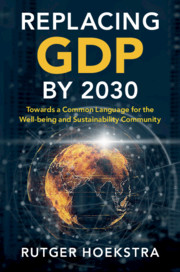Book contents
- Replacing GDP by 2030
- Advance Praise for Replacing GDP by 2030
- Replacing GDP by 2030
- Copyright page
- Dedication
- Contents
- Figures
- Tables
- Boxes
- Preface
- Acknowledgements
- Part I Why a New Strategy Is Needed
- 1 Replacing the Most Influential Indicator in the World
- 2 Why Is GDP Successful?
- 3 What Does GDP Measure (And What Not)?
- 4 Why Is Beyond-GDP Not Successful?
- Part II The New Strategy: A Community for Well-being and Sustainability
- Annex: Beyond-GDP Milestones and Measurement Systems
- Notes
- References
- Index
2 - Why Is GDP Successful?
from Part I - Why a New Strategy Is Needed
Published online by Cambridge University Press: 24 May 2019
- Replacing GDP by 2030
- Advance Praise for Replacing GDP by 2030
- Replacing GDP by 2030
- Copyright page
- Dedication
- Contents
- Figures
- Tables
- Boxes
- Preface
- Acknowledgements
- Part I Why a New Strategy Is Needed
- 1 Replacing the Most Influential Indicator in the World
- 2 Why Is GDP Successful?
- 3 What Does GDP Measure (And What Not)?
- 4 Why Is Beyond-GDP Not Successful?
- Part II The New Strategy: A Community for Well-being and Sustainability
- Annex: Beyond-GDP Milestones and Measurement Systems
- Notes
- References
- Index
Summary
GDP was not always as successful as it is today. National income accounting has existed for centuries but only started to take off in the 1930s and 1940s in a handful of countries. These new macroeconomic statistics proved to be useful in managing the aftermath of the Great Depression and were invaluable in planning during the Second World War. Building on these successes, the period after the war proved to be the "Golden Age" for macroeconomics and its key indicator GDP. Growth targets were set by many governments and economists became the most influential policy advisors. A powerful institutionalised community emerged that is based on a coherent policy science (macroeconomics), accounting framework (the System of National Accounts, SNA) and a key indicator (GDP). The most important feature of any community is a common language, and the SNA serves as the dictionary and grammar book for macroeconomics. Whether you are a macroeconomist in Sri Lanka, Senegal or Slovenia, all use this common language. Macroeconomic thinking was in turmoil in the 1970s and after the 2008 financial crisis, but the underlying language has endured.
- Type
- Chapter
- Information
- Replacing GDP by 2030Towards a Common Language for the Well-being and Sustainability Community, pp. 27 - 53Publisher: Cambridge University PressPrint publication year: 2019



